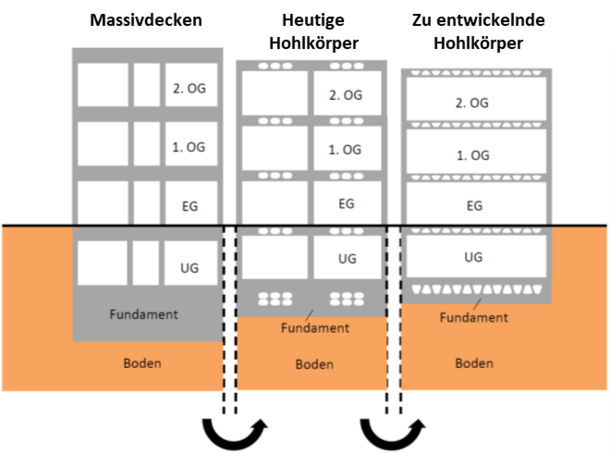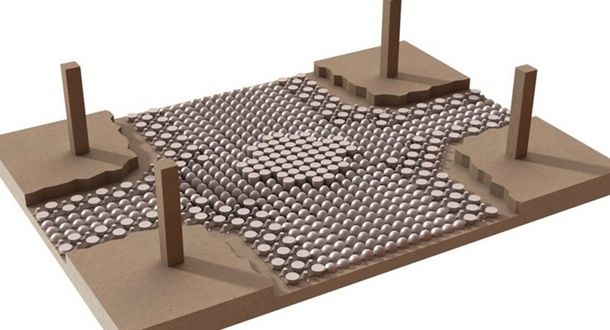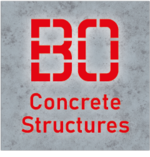Research
Overview of current research projects
Project Partners


Focus of Research
The building material (reinforced) concrete continues to dominate the global and German construction industry. The production of one ton of cement required for concrete releases 0.61 tons of CO2. In building construction alone, around 2.5 billion tons of cement are consumed worldwide. Slabs and foundations in building construction alone account for 55% of this, i.e. around 1.4 billion tons of cement and 0.83 billion tons of CO2.
One solution for reducing the use of concrete in slabs and foundations is the use of voided slabs, which offer a potential saving in material and CO2 of around 25% compared to solid concrete slabs. However, the disadvantage of previous void former systems is the substantial reduction in the shear force capacity compared to solid concrete slabs, so that the effective application area is reduced to approx. 60 % of the slab or foundation area. As a result, lightweight structures with voided slabs have often been at a cost disadvantage compared to solid slabs/foundations. Despite the environmental advantages of void former systems, the vast majority of slabs and foundations are therefore still built using solid construction methods.

Research Objective
The main goal of this project is to increase the shear force capacity of biaxial voided slabs and foundations by 50%, thereby maximizing the area of application of the void former technology and the potential savings in terms of material and CO2. This is to be achieved through a new geometric principle of void former technology. These are truncated cone-shaped void formers, which are installed with the “pointed” side alternating upwards and downwards, thus precisely mapping the stress state in slabs/foundations. The increased shear force capacity of the new void former technology means that it may also be used in areas close to walls and columns. This increases the area of application up to 80 % of the entire slab/foundation. This approach saves up to 40 % of the concrete used in slabs and foundations. In addition, for the first time they should also have considerable cost advantages compared to solid slabs, so that they can be used across the board and achieve a rapid, acute and high environmental impact.
air-Kon-Matrizen

The joint research project ‚air-Kon-Matrizen: Aufblasbare, individuell geformte, ressourcendschonende und konfektionierbare Hohlkammer-Matrizen für die Herstellung von Leichtbaufundamenten‘ was funded within the scope of the ‚Technologietransfer-Programm Leichtbau‘ of the Federal Ministry for Economic Affairs and Climate Action (BMWK).
The aim of this project is to develop custom-made, inflatable void formers that are applied in foundation slabs and displace the concrete where it is not required for the load-bearing capacity. Similar to the voided slabs already in use, this should save up to 40 percent of the amount of concrete. By reducing the amount of concrete used, the energy consumption required for production and transport can be considerably reduced, thus substantially lowering the associated greenhouse gas emissions.
In addition to the actual load effects, reinforced concrete structures are subject to additional constraining effects during their service life. These constraining effects arise when a component tends to lengthen or shorten as a result of concrete shrinkage or temperature effects, but is prevented from such deformations by its supports. The described constraining forces can only be determined exactly by calculation with considerable effort and are therefore usually estimated conservatively in practice. This results in an immense waste of reinforcing steel. The aim of the research project is to develop an easy-to-use method for a realistic estimation of the constraining forces in reinforced concrete slabs.





